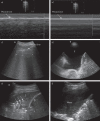The efficacy of bedside chest ultrasound: from accuracy to outcomes
- PMID: 27581823
- PMCID: PMC9487212
- DOI: 10.1183/16000617.0047-2016
The efficacy of bedside chest ultrasound: from accuracy to outcomes
Abstract
For many respiratory physicians, point-of-care chest ultrasound is now an integral part of clinical practice. The diagnostic accuracy of ultrasound to detect abnormalities of the pleura, the lung parenchyma and the thoracic musculoskeletal system is well described. However, the efficacy of a test extends beyond just diagnostic accuracy. The true value of a test depends on the degree to which diagnostic accuracy efficacy influences decision-making efficacy, and the subsequent extent to which this impacts health outcome efficacy. We therefore reviewed the demonstrable levels of test efficacy for bedside ultrasound of the pleura, lung parenchyma and thoracic musculoskeletal system.For bedside ultrasound of the pleura, there is evidence supporting diagnostic accuracy efficacy, decision-making efficacy and health outcome efficacy, predominantly in guiding pleural interventions. For the lung parenchyma, chest ultrasound has an impact on diagnostic accuracy and decision-making for patients presenting with acute respiratory failure or breathlessness, but there are no data as yet on actual health outcomes. For ultrasound of the thoracic musculoskeletal system, there is robust evidence only for diagnostic accuracy efficacy.We therefore outline avenues to further validate bedside chest ultrasound beyond diagnostic accuracy, with an emphasis on confirming enhanced health outcomes.
Copyright ©ERS 2016.
Conflict of interest statement
Conflict of interest: None declared.
Figures



Comment in
-
Should point-of-care ultrasonography replace stethoscopes in acute respiratory failure?BMJ. 2019 Aug 30;366:l5225. doi: 10.1136/bmj.l5225. BMJ. 2019. PMID: 31471372 No abstract available.
References
-
- Koenig SJ, Narasimhan M, Mayo PH. Thoracic ultrasonography for the pulmonary specialist. Chest 2011; 140: 1332–1341. - PubMed
-
- Hew M, Heinze S. Chest ultrasound in practice: a review of utility in the clinical setting. Intern Med J 2012; 42: 856–865. - PubMed
-
- Volpicelli G, Elbarbary M, Blaivas M, et al. . International evidence-based recommendations for point-of-care lung ultrasound. Intensive Care Med 2012; 38: 577–591. - PubMed
-
- Platz E, Solomon SD. Point-of-care echocardiography in the accountable care organization era. Circ Cardiovasc Imaging 2012; 5: 676–682. - PubMed
Publication types
MeSH terms
LinkOut - more resources
Full Text Sources
Other Literature Sources
